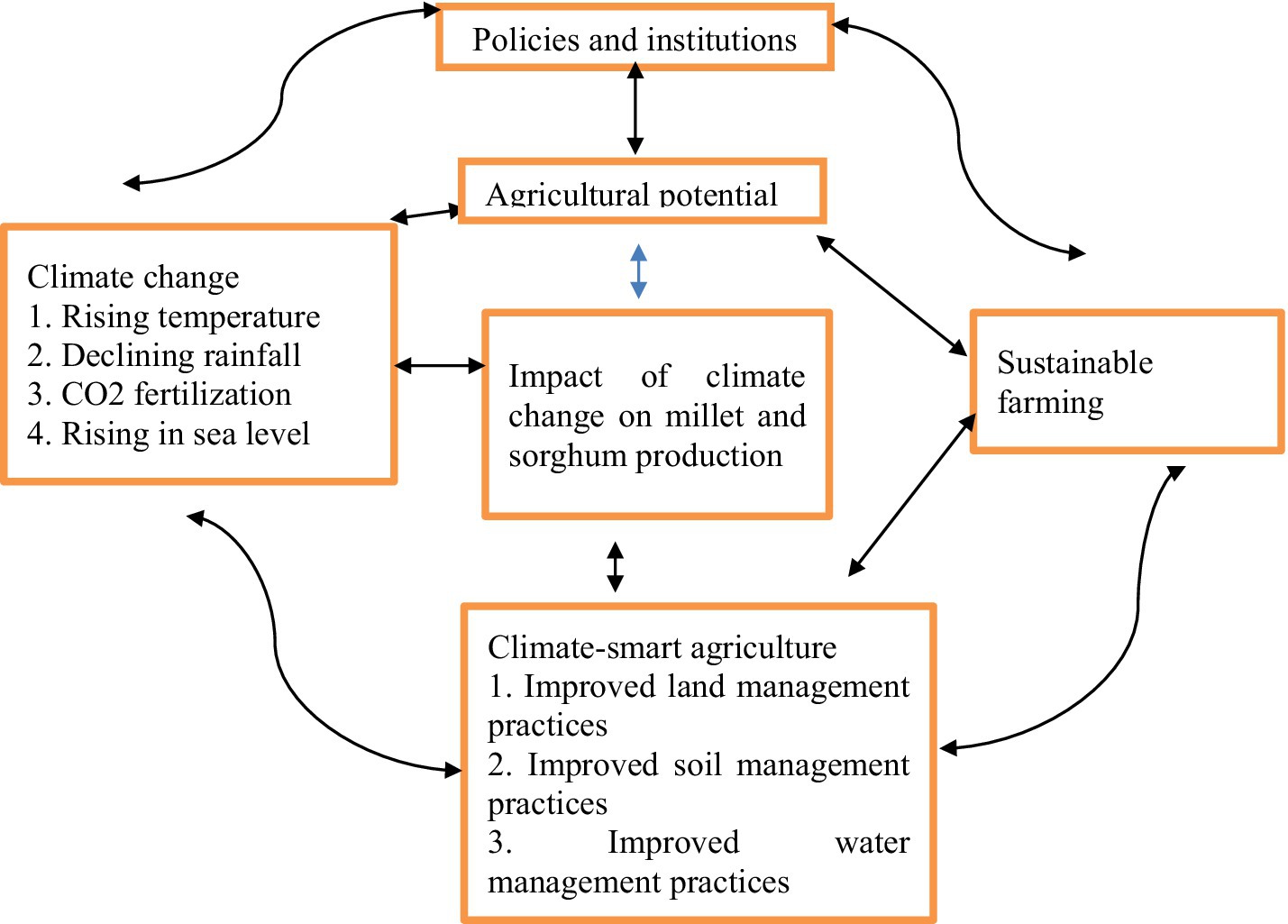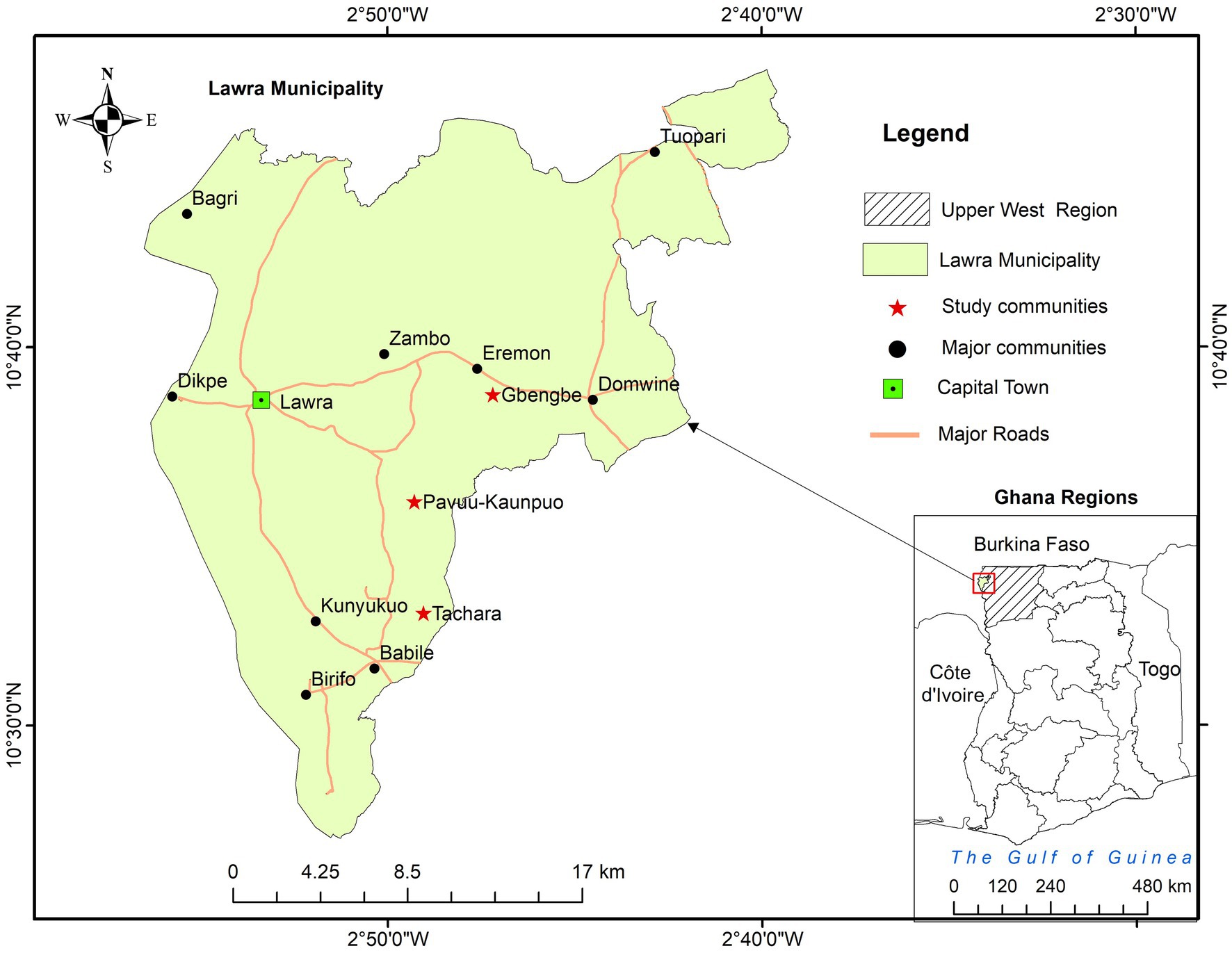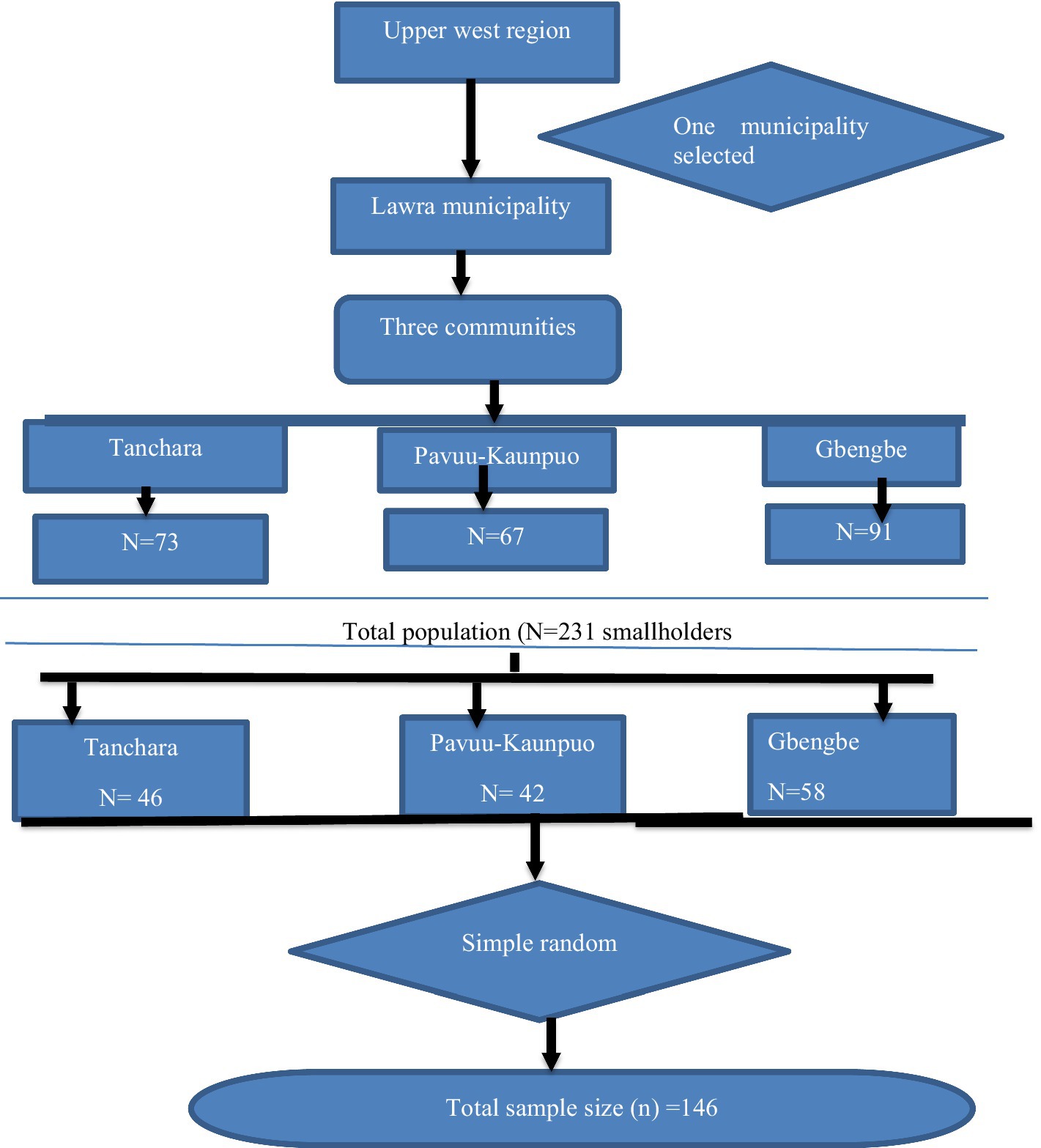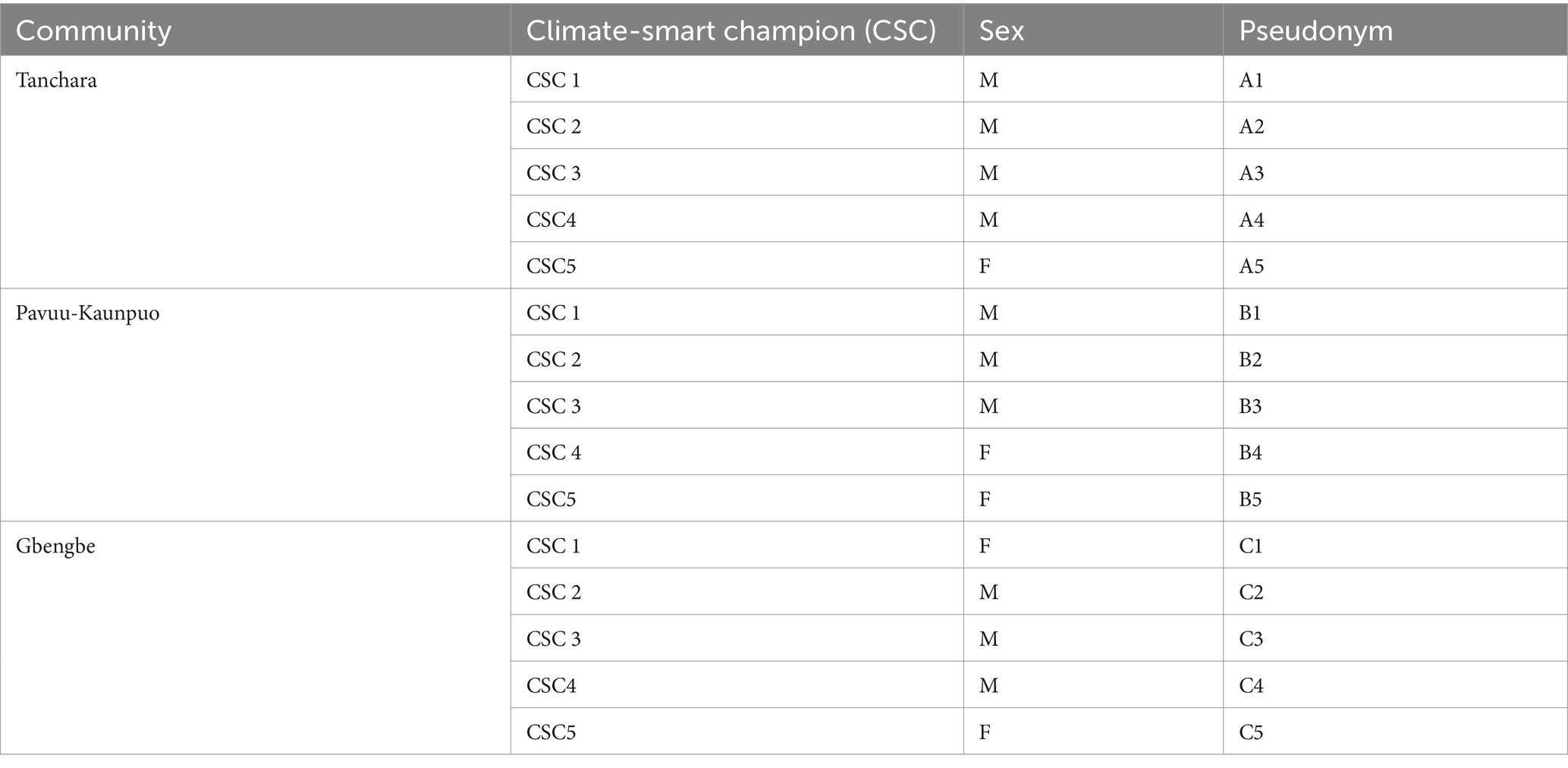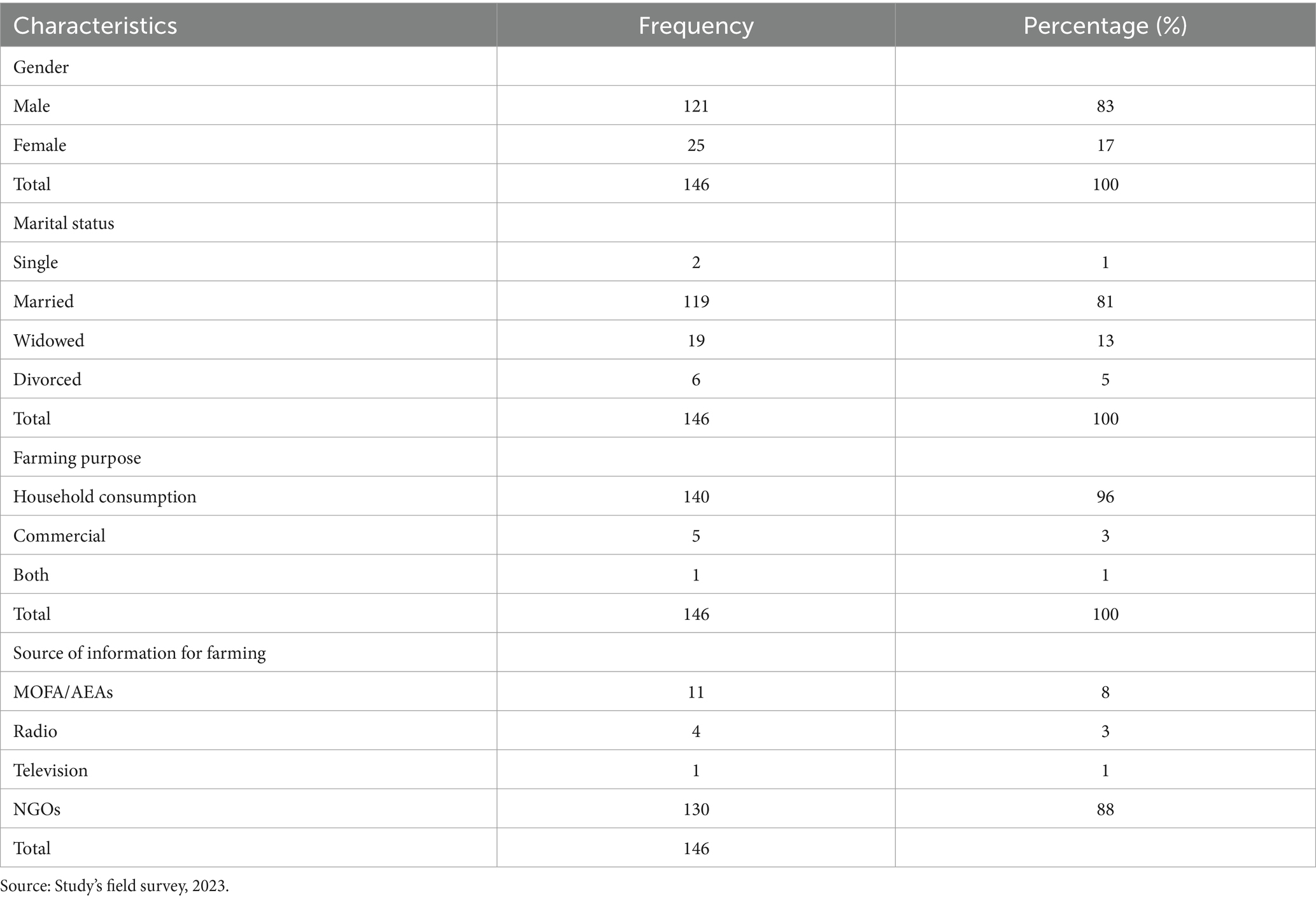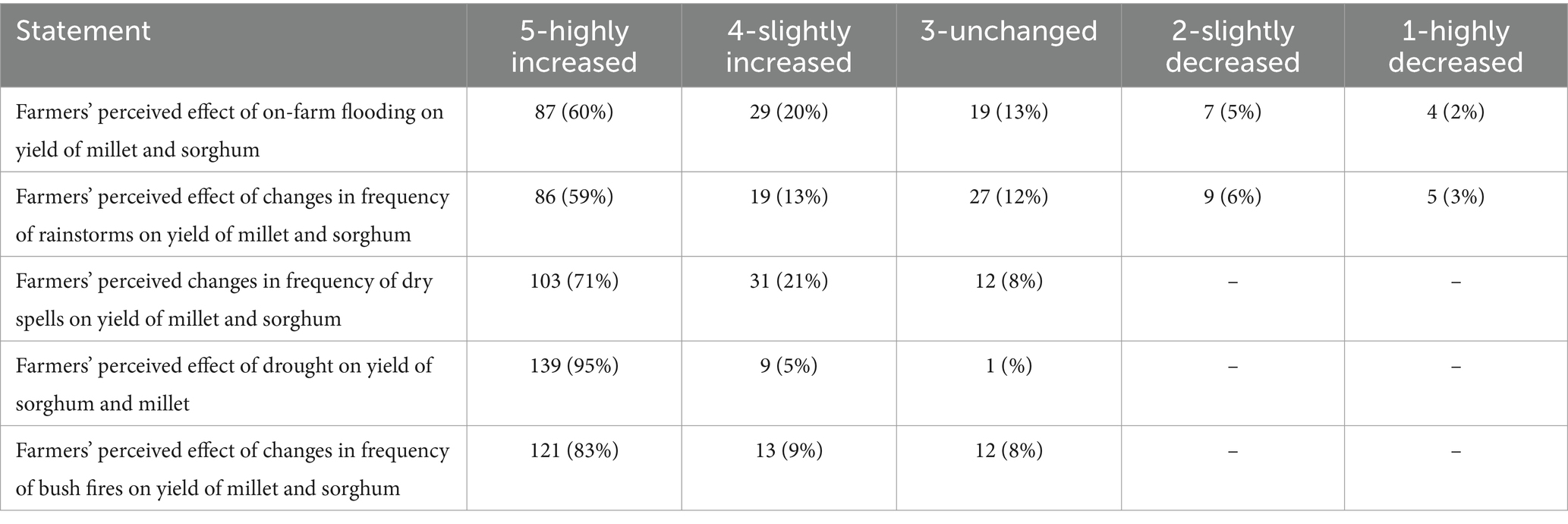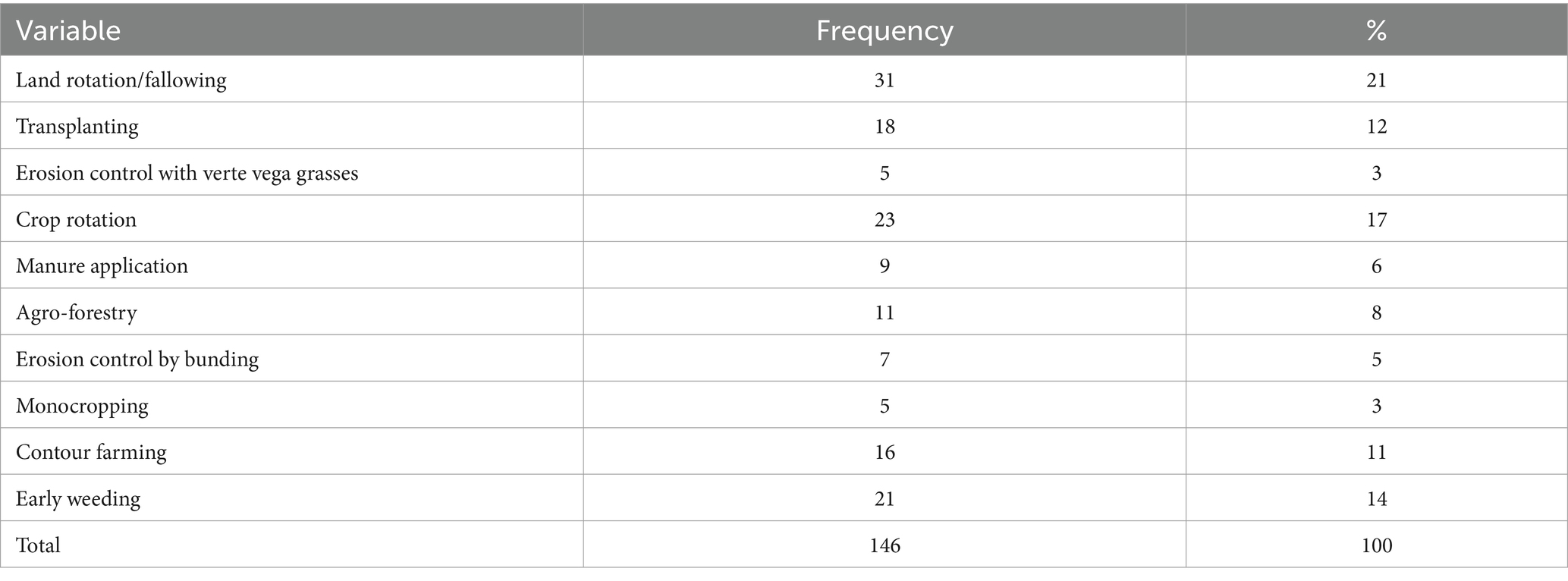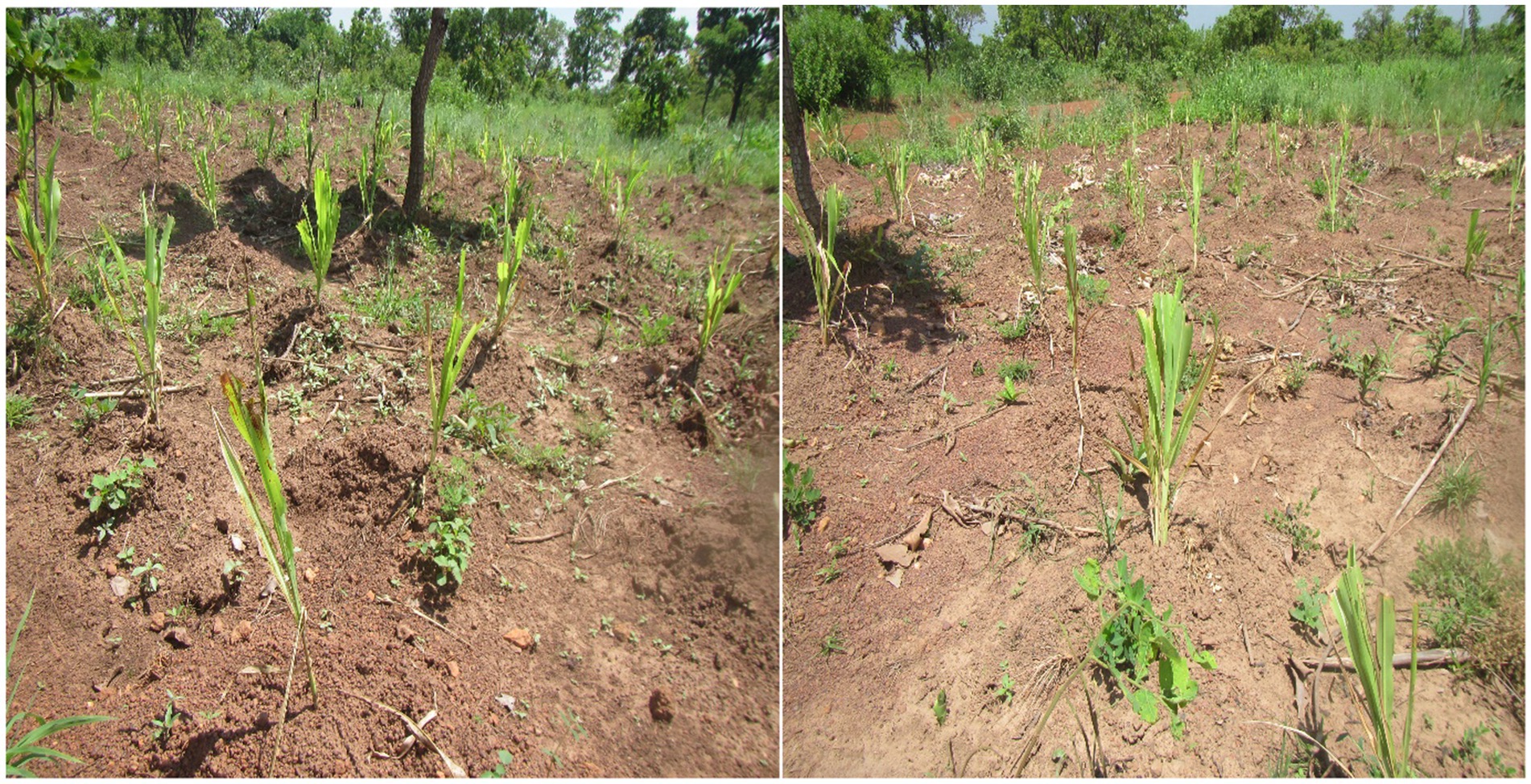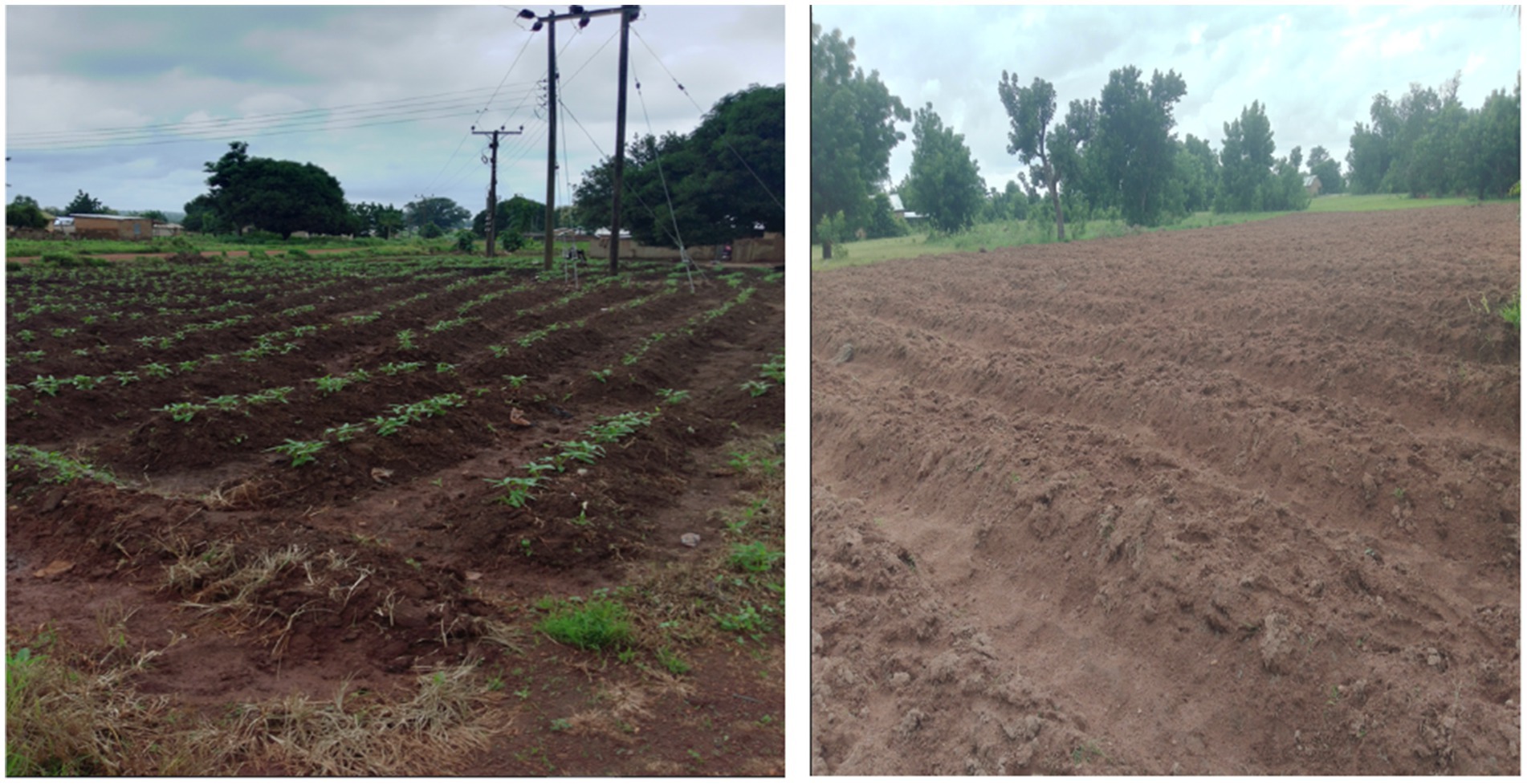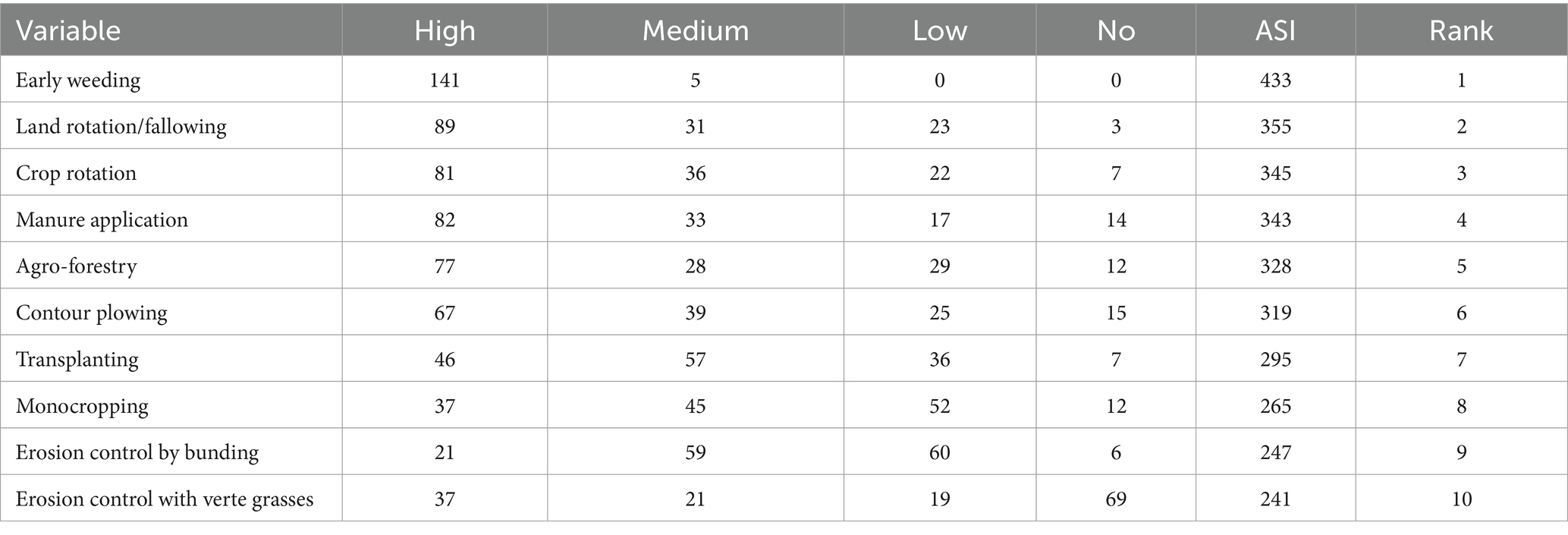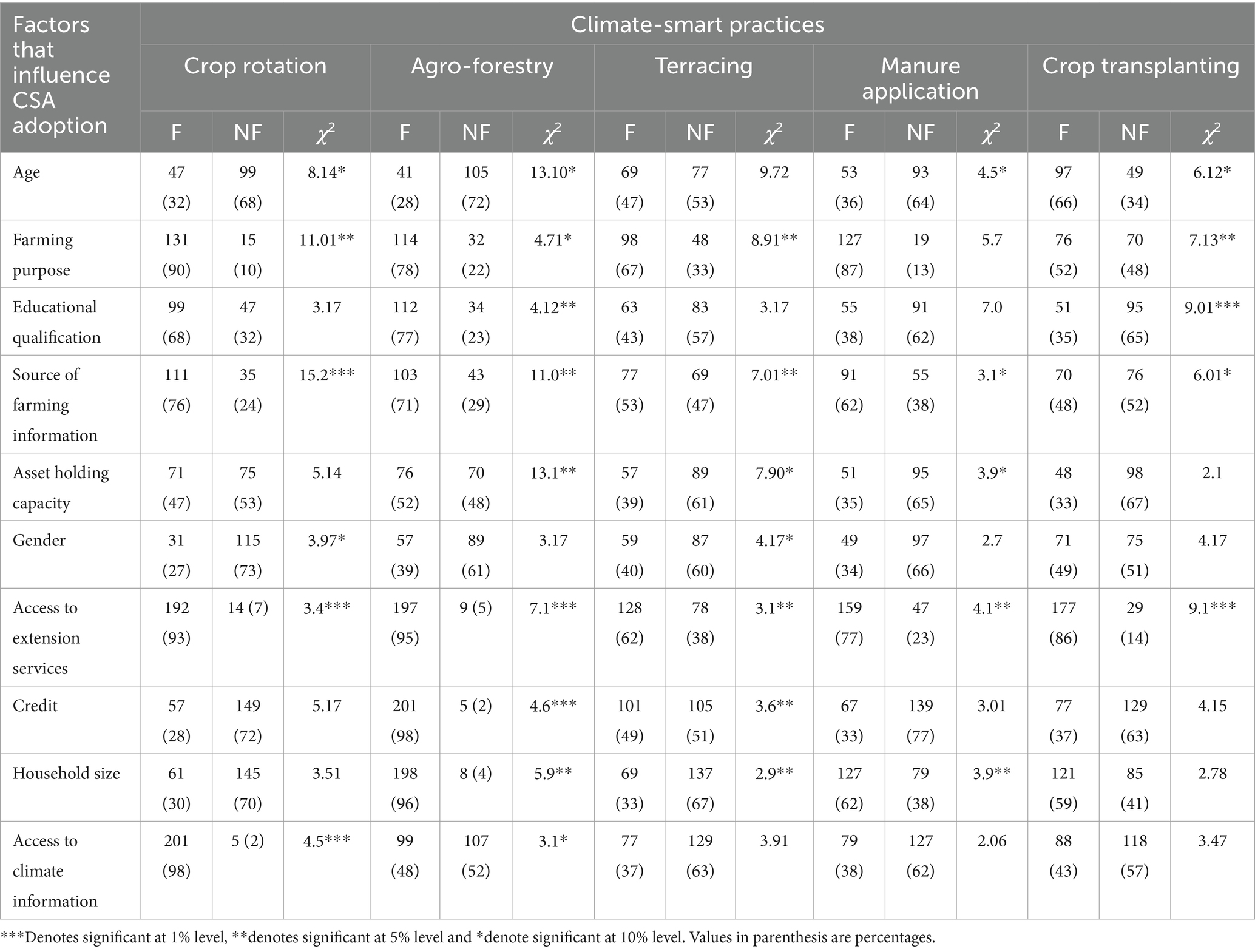- 1Department of Community Development, Faculty of Planning and Land Management, Simon Diedong Dombo University of Business and Integrated Development Studies, Wa, Ghana
- 2Department of Planning, Faculty of Planning and Land Management, Simon Diedong Dombo University of Business and Integrated Development Studies, Wa, Ghana
Reducing vulnerability of smallholder farmers to climate change is a global issue. One approach viewed as important in reducing farmers’ vulnerability to climate change is Climate-Smart Agriculture (CSA). CSA is often seen as an approach to redefine, reposition and sustainably manage agriculture. Given the importance of CSA practices in sustaining the food needs of many farm households in sub-Saharan Africa and Ghana, this study investigates CSA practices that were introduced to farmers by Center for Indigenous Knowledge and Development (CIKOD), interrogates the contributions of CSA to reducing farmers vulnerability to climate change and established the relationship between CSA and climate change adaptation. The study employed a mixed method approach, using 146 smallholder millet and sorghum farmers. Questionnaire and interviews were used to generate primary data for analysis. Descriptive statistics, involving Chi-square test and relative importance index were used to analyze the questionnaire while thematic analytical approach was used to analyze the interviews. The results of the study revealed that CSA practices such as crop rotation, weed control, contour farming, and land rotation are deployed by smallholder farmers to respond to drought, dry spell and flood in the Municipality. Asset holding capacity, credit, access to climate information, and extension services were found to be key determinants of farmers’ adoption of CSA practices. The study recommends the need for the Ministry of Food and Agriculture to provide some technical support to smallholder farmers to successfully adopt these practices for sustainable farming. Again, the study recommends the need for non-governmental organizations and development partners, which over the years have shown interest in promoting CSA practices among farmers, to continuous to support and promote the adoption of CSA by farmers.
1 Introduction
The global population is projected to increase to around 8.5 billion in 2030, 9.7 billion in 2050 and 10.4 billion in 2100 (FAO, 2022; Petrakis et al., 2023). This projected increase in population numbers will imply that agriculture must be at its best to meet the food needs of the growing population. With agricultural productivity projected to decline by 17–28% in sub-Saharan Africa due to farming systems’ sensitivity and vulnerability to volatile climatic conditions, poor agricultural households will suffer to meet their household food demand (Sakho-Jimbira and Hathie, 2020). Studies have observed that sub-Saharan Africa is highly sensitive and more vulnerable to climate change and suggest the need to improve their agricultural production systems to tackle the threats of climate change and other weather uncertainties (Pereira, 2017; File and Derbile, 2020; Owusu et al., 2021). No doubt, climate change has become a critical development challenge and net threat to achieving sustainable development. Given the importance of agriculture in meeting the current and future food needs of the global population, investment, and adoption of agricultural technologies need to be considered.
In recent years, there has been serious advocacy for sustainable agriculture. The call for sustainable agriculture is to improve agricultural productivity and incomes of farmers while managing the emission of greenhouse gasses into the atmosphere (FAO, 2013; Zougmoré et al., 2016; Anuga et al., 2019; Zakaria et al., 2020; Autio et al., 2021). One approach that appears dominant in the call for resilience and sustainable agriculture is climate-smart agricultural practices. Climate-smart agriculture is an approach that seeks to: (1) increase agriculture productivity in a sustainable manner, (2) improve the resilience of agricultural production and food systems to climate change and (3) reduce net greenhouse gas emissions associated with agriculture and forestry sectors (FAO, 2013; Yiridomoh, 2021). According to the Rainforest Alliance et al. (2024), CSA is an approach that combines different methods to increase agricultural food production under a climate change umbrella. The promotion of climate-smart agriculture is observed to enhance agricultural productivity and increase the resilience of farming systems against climate change (FAO, 2013; Zakaria et al., 2020; Azadi et al., 2021). Globally, studies have recognized the criticality of climate smart agriculture to sustainable agriculture and food security (Zougmoré et al., 2016; Azadi et al., 2021). Attention in the development, promotion, and adoption of climate-smart agricultural practices has always targeted at least developed regions, especially sub-Saharan Africa due to the region’s sensitivity and vulnerability to climate change.
The latest Intergovernmental Panel on Climate Change report shows that sub-Saharan Africa (SSA) will continue to experience decline in grain yields due to climate change (Ayanlade et al., 2023). Studies specifically on climate-crop modeling suggest that activities of agriculture will be disproportionately affected in SSA (Owusu and Yiridomoh, 2021; Derbile et al., 2022). Given that majority of the people depend on agriculture for their livelihood, agricultural vulnerability to climate change is of great interest to policy makers, academics and other development partners. The decision for climate change adaptation as a global public goal is enshrined in the Paris Agreement (Article 7). The question for many sub-Saharan countries is when and how to act and which adaptive strategies to pursue to reduce the fragility of agricultural systems for sustainable food production. This is because without sustainable and appropriate farm-level responses and interventions, climate change will likely affect agricultural yields and food security, and increase poverty levels in SSA. Earlier studies have observed that CSA technologies must be introduced to farm households in Africa and other developing economies (Alexander, 2019; Mashi et al., 2022; Njogu et al., 2024). Accordingly, the introduction of climate smart-agricultural practices to smallholder farmers has the propensity to support sustainable agriculture through improved agricultural productivity, income, and food security. However, despite the call for the implementation and promotion of CSA in sub-Saharan Africa, the specific role CSA plays in sustaining grains cultivation (specifically millet and sorghum) in Ghana is limited and least investigated.
Just as in Ghana and in other parts of Africa, millet and sorghum are important crops that are cultivated all over the world particularly, Asia and America. In Ghana, the farming of millet and sorghum are closely associated with the indigenous culture over centuries. Millet and sorghum have been mixed cropped for centuries and are nutritionally preferred to others cereals such as barley, wheat, rice and maize. According to Prasad and Staggenborg (2009), the two crops contain high levels of calcium, iron, fiber, and relatively lower energy content, which make them ideal for weaning children. Local knowledge shows that the two crops form the staple diet of major communities within the northern and other parts of Ghana where they are used to make local dishes such as Tuo Zaafi (TZ), fura, and zoom (kom) (Agyakinla, 2018). Despite the significant role of millet and sorghum in household food security, climate change is observed to impact the yield of these two crops. As observed by Derbile et al. (2022), the yield of the two crops has been declining since 1990. This has plunged the area cropped of millet and sorghum to 3rd and 4th places among the most cropped food plants in Ghana [Ministry of Food and Agriculture (Ministry of Food and Agriculture, 2010)] and overtaken by other cereals like maize and rice.
Situated in North-western Ghana, the Lawra Municipality is one of the municipalities in the Upper West Region where millet and sorghum are predominantly cultivated for food and the cultural needs of the people. In fact, they are the first choice crops that are cultivated within the municipality, and almost all farm households within the municipality cultivate the two crops for their food security needs and traditional rites (Ministry of Food and Agriculture, 2010; Seglah et al., 2022). In recent years, development partners, including the Center for Indigenous Knowledge and Development (CIKOD), have introduced smallholder farmers to climate-smart agricultural technologies in the municipality for sustainable farming. Previous studies have given attention to factors that influence farmers’ adoption decision to CSA practices. However, how adoption of these CSA practices has supported farmers to adapt to climate change especially in resource-scare location of Ghana is least interrogated. Thus, this study seeks to answer the following questions: (1) What are the climate-smart agricultural practices introduced to farmers? (2) What are the contributions of the introduced CSA technologies for farm-level adaptation? (3) What are the associations between CSA practices and climate change adaptation? Providing answers to these questions do not just contribute to critical literature on CSA adoption but also provide a framework for understanding the nexus between CSA and climate change adaptation in resource scarce setting in north western Ghana. The rest of the paper is organized as follows: the succeeding sections consist of the conceptual framework, the methodology, results and the discussions of the study.
1.1 Climate-smart agriculture and climate vulnerability reduction of farmers
Climate vulnerability has become important in climate change research globally. Vulnerability studies are key to define systems exposure and sensitivity to climate change for systems adaptation decisions. Often viewed as a contested concept, vulnerability is when people are prone to future acute loss in capacity to respond to climate-induced disasters. In other words, vulnerability is the tendency to be adversely affected by actions and inactions of climate change. Climate vulnerability is widely known to differ within communities and across societies, regions and countries, and also through time (Ayanlade et al., 2023). Agriculture in Africa and other developing economies are observed to be vulnerable to global and local climate change. The agricultural sector vulnerability to climate change in Africa, in particularly, is due to the sector’s high reliance on rainfall for its activities (Wekesa et al., 2019; Yiridomoh et al,. 2020). Studies across Africa and the globe observed food crop yields reduction in the coming years due to low adaptive capacity of farmers to climate change (Eggen et al., 2019; Sultan et al., 2020; Ayanlade et al., 2023). Using a large ensemble of historical climate stimulations derived from an atmospheric general circulation model and two process-based models (SARRA-H and CYGMA) to assess climate effects on crop production in West Africa, Sultan et al. (2020) observed that climatic conditions have caused regional average yield reductions of 10–20% for millet and 5–15% for sorghum in the two models. Using a participatory approach to assess sources of vulnerability of farmers to climate change in Zimbabwe, Rurinda et al. (2014), found that food crops of farmers have been affected by multiple stress factors such as soil degradation, water deficit and limited rainfall caused by climate change.
Climate change and agriculture will continue to interact with the former setting the development pace for the latter. This implies that developing and implementing emerging agricultural technologies is core to agricultural development. Over the years, climate-smart agriculture has been seen as an approach to support farm households respond to climate. The approach is premised on three pillars; increase yields of farmers through adaptation, improve income of farmers and assist in mitigating climate change through reduction in greenhouse gasses. Climate-smart agriculture, over the years has been observed to reduce farmers’ exposure and vulnerability to climate change through improved yields of farm activities. For instance, Tesfaye A. et al. (2021) study in Ethiopia on climate-smart innovations and rural poverty reported that climate-smart technologies such as cereal-legume intercropping, minimum tillage and their combination (cereal-legume plus minimum tillage) have helped reduce the incidence and depth of poverty of smallholder farmers. Sarr et al. (2021) study on who benefits from climate-friendly agriculture in Tanzania found that intensification of rice system significantly contributed to improved rice yield. In Ghana, Issahaku and Abdulai (2019) reported that climate-smart innovations such as water and soil conservation and crop choices has resulted in reduction in multi-dimensional poverty and downside risk exposure of farmers to climate and environmental change. The study further observed that adopting climate-smart agricultural practices positively and significantly impacts food and nutritional security.
Martey et al. (2020) study on climate-smart innovations on food security reported that adopting row planting and drought-tolerant maize varieties increased crop yield and intensity of maize commercialization. Shahzad et al. (2021) on climate-smart agricultural practices in Pakistan, revealed that climate-smart technologies such as cropping calendars, diversified seed varieties, changing input mix and soil, and water conservation measures significantly improve household food security and enhance household dietary diversity. Other studies have also reported on yield and income effects of climate-mart agricultural innovations (Miller et al., 2021; Bazzana et al., 2022; Li et al., 2022; Yamoah and Kaba, 2022; Ali et al., 2023). Li et al. (2022) study on climate-smart innovations and crop yield in China found that farmers who adopted CSAs have seen their rice yield increase. No doubt, climate-smart agricultural practices could play a significant role in reducing climate-related vulnerabilities of farmers if they are properly introduced to these technologies. This therefore suggests that building the synergies between indigenous knowledge systems and climate-smart agricultural technologies could proffer successful climate adaptation solutions to farmers.
1.2 Conceptual framework of the study
As indicated by the sustainable farming framework (SFF), climate change is a threat to the agricultural sector. Rising temperatures, declining rainfall, and rising sea levels are observed to impact activities of farming. As already reported by previous studies, the impact of climate change has grave implications on the agricultural sector because of the sector’s high dependence on rainfall for its activities (Yiridomoh et al., 2021; Belford et al., 2023; Mehraj et al., 2023). As typified by the framework, climate change will determine agricultural potential and its impact will determine whether millet, sorghum and other crops will survive the test of climate change. As reported by earlier studies, the adverse impact of climate change will affect all sustainable farming practices, with consequent effects on food availability, accessibility, stability, and utilization (Owusu and Yiridomoh, 2021; Yiridomoh et al., 2021; Ayanlade et al., 2023). Thus, increasing weather extremes as noted by the framework (see Figure 1), will force many vulnerable households into food insecurity due to exposure of food production systems to climate change. In some cases, household vulnerability may result in maladaptation due to severe impact of climate change on farm activities.
Sustainable farming as depicted by the framework depends heavily on climate-smart agricultural technology adoption. Thus, reducing vulnerability of farmers to climate change will imply that they are introduced to climate-compatible agricultural activities such as land, soil and water management practices. Studies have indicated the need to provide strategies to enlarge potential crop production through expanding rain-fed and irrigated agricultural areas (Antwi-Agyei et al., 2021; Owusu and Yiridomoh, 2021; File et al., 2023). No doubt, there exists extant literature on smallholder farmers’ vulnerability to climate change through frequent crop failures, reduced cropping areas due to climate extremes such as droughts and floods, especially in developing countries. Sustainable farming through adoption of climate-compatible farming practices is a must to protect smallholder farmers against harsh climatic conditions. Climate-smart agriculture supports farmers’ farm decisions for sustainable farming as exemplified by Figure 1. The opportunities for adoption of climate-smart agricultural activities are to reverse the impact of climate change on farming activities. As reported by studies, adoption of climate smart agriculture is to enhance farmers’ capacity for climate change vulnerability reduction through adaptation (Makate et al., 2019; Jamil et al., 2021; Nyang'au et al., 2021).
Climate-smart technologies’ adoption requires government policy intervention which sometimes could be complex public planned adaptation projects to include weather prediction, irrigation for water conservation, sustainable soil management, introduction of improved crop varieties and livestock management. The effectiveness of public policies and institutions in climate-smart agricultural technologies adoption will have positive implication on sustainable and future farming. This implies that for farmers to appropriately adopt climate-smart agricultural technologies for sustainable farming, public institutions and their policies must be tailored toward smallholder farmers to support the climate adaptation behavior. As reported by studies, how and when climate-smart technologies are used by farmers is dependent on how these policies are developed and implemented by institutions (Totin et al., 2018; Makate et al., 2019; Tanti et al., 2022). Strong public policies and institutions are prerequisite requirements for the adoption of climate-smart agricultural technologies and have consequential effects on sustainable farming.
2 Materials and methods
2.1 Study location
The Lawra Municipality is one of 11 Districts in the Upper West Region of Ghana. The municipality is bounded to the east by the Lambussie-Karni district and to the west and south-west by the Republic of Burkina Faso and located within the Guinea Savanna vegetation zone of Ghana (see Figure 2). The guinea Savanna zone is characterized by scattered woody trees, which are usually short in height. The area is known for its short grasses except areas along the Black Volta River where the grasses are taller. Most of the trees in the municipality are drought and fire resistant, making them more resilient to climate and environmental changes. For instance, baobab, dawadawa, shea, and acacia are the most common trees in area, and these are highly resistant to drought and wild fires. These trees are of economic importance to the sustenance of the residents in the municipality as they provide extra income to farm households, especially women.
One annual environmental challenge of the area is drought, which usually starts from early October and runs through to early April. When the drought occurs, the grasses become dry and get burnt subsequently. This usually leaves the area very patchy and bare. The early torrential rains which are unpredictable these years also set in around April and May. These are the months in which farmers start to clear their lands for activities of farming. Due to the erratic nature of the rainfall, farming and other agricultural activities are affected, resulting in low agricultural yields as farmers depend mostly on rain-fed agriculture. The climate of the municipality is the tropical continental type. This is characterized by mean annual temperature ranging between 27 and 36°C. February to April is the hottest period in the municipality and the region at large, while April to October is the period in which the municipality receives rainfall, which usually is the wet and farming season.
2.2 Study design
Based on the paradigm of pragmatism (Johnson et al., 2007), which focuses on research outcomes and allows researchers freedom in the choice of methods that best meet their needs, an exploratory sequential mixed-methods research design was adopted for the study. An exploratory sequential design involves a study in which the qualitative dimension (data collection and analysis) of the study is conducted first followed by the quantitative data collection and analysis (Fetters et al., 2013). The interest in the exploratory sequential mixed methods approach is to present more balanced findings that would be relevant for agricultural sector climate change adaptation planning.
2.3 Population and sample
The study was conducted among smallholder farmers in 12 communities within the Lawra Municipality who were introduced to climate-smart agriculture by the Center for Indigenous Knowledge and Organizational Development (CIKOD) in 2014. The communities are Tanchara, Tanchara Saazu, Kporo, Daboziire, Dawna, Gbelinkaa, Pavuu-Kaungpuo, Tiakoni, Danllar, Gangduor, Gbengbe, and Dobozirre. A purposive and simple random sampling techniques were used to select the municipality and the communities, respectively. The Municipality was purposely selected because of its introduction to climate-smart-agricultural practices, high poverty indices and its vulnerability to climate change. Thus, the purposive sampling approach was used to select the Lawra municipality and simple random sampling was used to select three communities out of the 12 for the study. By way of applying the simple random approach, all the 12 communities that were introduced to the CSA practices names were interdependently written on pieces of papers, gently folded and put into a container for the three communities to be drawn among the folded list of communities. Simple random sampling technique was again employed to recruit the individual farmers for the study. Simple random is suitably used when the population under study has homogenous characteristics. In this study, the researchers deployed the simple random sampling by first assigning consecutive numbers from 1 to n, next to each farmer in each community under study (i.e., n = population of farmers in each community). Second, a list of random numbers with the help of random number table which was manually developed enable the researchers select the number of farmers in each community from the total list of farmers of that community (see Figure 3).
For the selection of the sample size for the study, a proportionate sampling approach guided by data collected from CIKOD (see Figure 3) was used. Using the Yamane (1967), formula: , where n = sample size; Ν = sample frame, and е = disturbance term, which was (0.05), a sample size of 146 millet and sorghum farmers was used for the study.
2.4 Data collection instruments
Two data collection instruments were used; in-depth interviews and structured questionnaire. In-depth interviews were conducted with climate-smart champions in all the three communities in the municipality. Climate-smart champions are millet and sorghum farmers recognized by their peer farmers as real adopters of climate-smart agricultural practices. The interview with the climate-smart champions was face-face interaction between the researchers and the individual respondents (Climate-smart champions). The adoption of the face-face approach is because it offers a greater degree of flexibility. It provides an avenue where answers are probed by the researcher and clarification made where necessary by the respondent on questions for better comprehension before answering. The climate-smart champions were identified with the help of farmers during the questionnaire administration. A follow up was made on the names mentioned to the research team and interviews were conducted with them too. It was the intention of the study to conduct 15 interviews with the climate-smart champions, however, after 12 interviews (see Table 1), data saturation was reached and the interviews were stopped. All the interviews, which usually lasted for 30–45 min, were conducted with farmers at their homes.
Just like the in-depth interviews, the structured questionnaire was granted to millet and sorghum smallholder farmers on their perspectives of climate-smart agriculture, the kind of climate smart technologies adopted by farmers and their contributions to climate change vulnerability reduction among the smallholder farmers. The structured questionnaires were administered to millet and sorghum farmers in their homes, with each questionnaire lasting for 40 min. For relevance and accuracy of the questionnaire to the success of the study, a pilot study was conducted in Babile, one of the communities in the Municipality. That procedure involved administering the developed questionnaire to millet and sorghum farmers and then following up to get responses on the questions on how they are structured, and whether they were understood by the respondents and felt comfortable responding to them.
Before the study was conducted, all the participating communities’ consent was sought, and respondents’ confidentiality was assured. Where audio recordings were done, participants consent were asked and confidentiality in the management and use of the recorded audios was clearly assured.
2.5 Data analysis
The quantitative data was analyzed using descriptive statistics such as frequencies and percentages. The descriptive statistics was analyzed using Statistical Package for Social Scientists (SPSS Version 21). To determine the relationship between CSA and climate vulnerability reduction, a chi-square test (Greenwood and Nikulin, 1996) was performed to examine CSA practices that are significantly associated with climate risk reduction. To identify CSA practices that were perceived effective and of importance to the farmers over others, a Relative Importance index (RII) analysis was conducted. Farmers were asked to score the relative importance of the different CSA practices using a four-point rating scale (high, medium, low and no). The relative importance index was calculated based on the following index formula RII = RIn + 0 + RI I × 1+ RI m × 2 + RI h × 3… (2) Where; RII = Relative Importance Index, RIn = frequency of farmers rating CSA practice as not important, RIi = frequency of farmers rating CSA practice as less important RIm = frequency of farmers rating CSA practice as moderately important RIh = frequency of farmers rating CSA practice as highly important (Uddin et al., 2014). For the qualitative data, thematic approach was used (Attride-Stirling, 2001). Thus, all interviews were transcribed by the first author and shared the transcripts with the other two authors for codes and themes identification. The transcripts were independently read by the three authors to identify the codes and themes for analysis. The individual researcher’s read of the transcripts helped the authors identify themes relevant to make a case for the contribution of CSA for climate vulnerability reduction. The themes identified were used to support the descriptive statistics to present a more balanced results of the study.
3 Results
3.1 Demographic characteristics of respondents
The study presents the demographic characteristics of the millet and sorghum farmers in the Lawra Municipality (see Table 2). From the analysis, 83% of the respondents were male while 17% were female. The male dominance in the production of the millet and sorghum, according to the study, is because these crop varieties are considered as traditional crops and usually cultivated for cultural and traditional purposes, in which women have limited roles. Again, the demographic analysis, revealed that 81% of the respondents were married, 13% were widows while 5 % of them were divorcees.
On production goal or purpose of engaging in millet and sorghum farming, 96% of the respondents indicated the production was for home consumption while three and 1 % indicated that production of sorghum and millet is for commercial and for both commercial and household consumption, respectively. Further analysis of the demographic information of the respondents indicated that, 88% of the farmers received farming information from NGOs, while 8 and 3% of the respondents indicated that they received farming climate information through the Ministry of Food and Agriculture and its subsidiary units.
3.2 Perceived effects of climate-induced variables on yield of millet and sorghum in the Lawra municipality
The perceived effects of climate-induced variables on the yield of millet and sorghum in the Municipality are presented (see Table 3). As indicated by the Table 3, various climate-induced derivatives were explored and farmers were asked if they had any effect on their sorghum and millet production. The responses of the participants revealed that drought, dry spells, windstorms, bushfires and floods had great implications on their millet and sorghum production. Specifically, 80% of the respondents observed that over the years floods had increased with grave consequences on their food crop production.
Millet and sorghum farmers also observed that rainfall over the years had been sporadic, however, they noted that any time they experienced heavy rainfall, their valleys and farm lands get flooded, with adverse consequences on the development of the sorghum and millet as captured by A1:
“Flooding has been part of our existence here. We have been experiencing flooding since time immemorial. However, in recent years, the flooding is devastating with adverse consequences on those of us who cultivate millet and sorghum. The worst affected are those who have their farm lands located along rivers and streams.”
On farmers’ responses to drought, respondents observed that drought has been rampant in the past decade causing farmers’ crops to wilt and dry up. Just like drought, farmers also mentioned dry spells, which are as devastating as the drought itself. As indicated by Table 3, 100 and 92% of the respondents indicated that drought and dry spells, respectively, were intense with dire repercussions on the yield of sorghum and millet. Farmers mentioned annual drought and dry spells especially around June–August where farmers expect rains for their farming activities. According to the farmers, due to limited rains experienced annually, bush fires set in quickly usually around October and November, and consume their crops. The farmers indicated that, sorghum and millet take 4–5 months to mature and are ready for harvest usually around October and November, but grasses and bushes get dried around the same period, and any bush fires around that period will cover a wide area, usually with sorghum and millet farms suffering the consequences.
Aside these climate-induced variables, windstorms were observed by the farmers to negatively impact millet and sorghum. According to the farmers, due to the height of the two crops, anytime there is windstorms precipitated by rainfall, most of the crops fall to the ground, and consequently, are unable to produce good grains.
3.3 Climate-smart agricultural technologies adopted
The study presents the climate-smart agricultural technologies adopted by the millet and sorghum farmers (see Table 4). As indicated by Table 4, 21% of the farmers used land rotation/fallowing as a response strategy to climate change. Again, the results indicated that 13% each of the farmers used early weeding for weeds control and transplanting of crops to respond to the changing climate system. The results further revealed that 18 and 11% of the respondents adopted to crop rotation and contour farming respectively, which support them reduce their vulnerability to climate change. The results also indicated that 7, 6, and 5% adopted agro-forestry, manure application, and erosion control by bunding, respectively, as climate-smart strategies to respond to climate change. The interview with the climate-smart champions revealed that land rotation or fallowing has been with them since time immemorial and has been playing a significant role in the climate change adaptation processes. According to the interviewees, fallowing or land rotation involves continuously allowing the land to freely lie for few years uncropped. The respondents mentioned that, land rotation has been noted among them as a smart strategy to respond to climate and environmental change which are now more pronounced in recent years as captured by C4:
Today, we are facing the reality of climate change. Our lands were not infertile years ago. We did the land rotation those days but not as frequently as we do today. Today, the frequent rotation of land is necessary to allow the land to possibly regain its lost fertility for crop farming. That has been a smart strategy majority of the farmers in this locality are adopting to respond to climate/environmental change.
The interview with the climate-smart champions further revealed that crop rotation, using leguminous crops assists farmers to sustainably manage soil fertility for millet and sorghum production. According to the farmers, leguminous crops such as soya beans, bambara beans, groundnuts and beans are rotated with millet and sorghum on yearly basis so that the later crops can benefit from nitrogen which is fixed into the soil by the former crops. The interviewees indicated that, just like land rotation, crop rotation has been with them for ages and has been very influential in their farm decision-making. Accordingly, crop rotation has aided them reduce soil susceptibility to climate and environmental change. Respondents framed crop rotation as a smart strategy to respond to soil degradation, caused by the changing climate system as captured by A3:
Crop rotation is as old as this community itself. However, it has now become more important to all farmers in this locality because of continuous loss of soil fertility. We do the crop rotation as a strategy to maintain soil fertility through the atmospheric nitrogen which is fixed into the soil by the leguminous crops, which are used by the millet and sorghum.
As indicated in Table 4, one of the climate-smart approaches farmers use to reduce vulnerability to crop failure is transplanting. According to the farmers, transplanting of crops is an indigenous smart way of responding to drought and dry spells which usually cause their crops to dry up. To do this, farmers broadcast the millet and sorghum seeds under a shade of a tree inside their farms to germinate. These are later transplanted to fill the spaces of the planted seeds that died due to drought or a dry spell. According to the farmers, under the shade of trees, the millet and sorghum seeds are able to withstand the drought and are then transplanted during the peak of the rains in either an open field or in the spaces left by the drying up of originally planted crops (see Figure 4). Because farmers, nurse the seedlings under trees, in times of extreme water stress, they are able to irrigate the crops without wasting water. This practice according to farmers helps them increase yields because a shorter season naturally leads to the late variety’s failure at worst or low yield; with this strategy they are able to crop them.
The study again found that farmers used mono-cropping as a smart approach to increase crop yield. According to the farmers, mono cropping helps increase plant population and reduce the density of different crops competition for soil nutrients and water. To implement this, farmers indicated that, lands for millet and sorghum are solely dedicated for that and no crop is intercropped or interjected on same piece of land. Farmers acknowledge the risk involved in mono cropping as the entire farm containing the millet or sorghum may collapse. However, they indicated that they have other farms where they do the intercropping, citing maize and groundnuts, and yam and beans.
One other dominant farming practice that was reported by the study was contour farming (see Figure 5). The contour farming involves raising mounds around the base of the millet or sorghum crop during the peak of the season using a hoe, a practice which is believed to increase fertility in the following season while creating runways for water passage during flooding of the field. According to the farmers, the contour farming plays several functions including; erosion control, supporting the base of the crops from falling down during windstorms and also improving the moisture content of the soil (see Figure 5).
Agro-forestry, as a CSA approach, was found to be used by farmers in response to climate change in the municipality. According to the farmers, trees such as mango, acacia, baobab, shea trees and neem are integrated into farm plots. According to the farmers, the agroforestry approach helps them find a balance in raising food crops and forest management. For the farmers, the adoption of agroforestry has the potential to increase the capacity of seasonal crops to tolerate drought and thus enhance farmer’s food security by avoiding total failure on the farm as captured by C1:
“Agroforestry is an approach we have been using all these years. We do not cut down the economic trees we find on our farm plots. Mango, shea, dawadawa, baobab etc. are trees we reserve on our farm plots. Besides the economic value for their reservation, these trees help increase the amount of organic matter in the soil through the dropping of the leaves onto the soil.”
3.4 Climate-smart agricultural practices and their relative importance
To determine the relative importance of CSA practices, a Relative Importance Index (RII) was performed. The results in Table 5 indicated that early weeding of farm plots by farmers was ranked as the most important CSA practice with a rank score of 433. Land rotation/fallowing and crop rotation were ranked second and third with rank scores of 355 and 345, respectively. CSA practices that were ranked as least important by the farmers were erosion control, monocropping and transplanting. Weeds control is critical to farm management as weeds compete with crops for nutrients and space. Just like the weed control, land rotation or fallowing plays a great role in soil and land management as the practice helps the soil to regain it fertility for crop growth and development.
3.5 Contributions of CSA practices in reducing climate change vulnerability of millet and sorghum farmers
On the contributions of CSA practices to climate change vulnerability, the results indicate that CSA has been playing critical support to farmers’ vulnerability reduction. As shown by Table 5, CSA has been supporting farmers to addresses challenges of climate variables including; drought, floods windstorms. As shown in Table 6, drought has been one of the climate variables that determine household food security and vulnerability through drying of crops of farmers and loss of soil moisture, making it highly difficult for farmers to meet the food needs of their families.
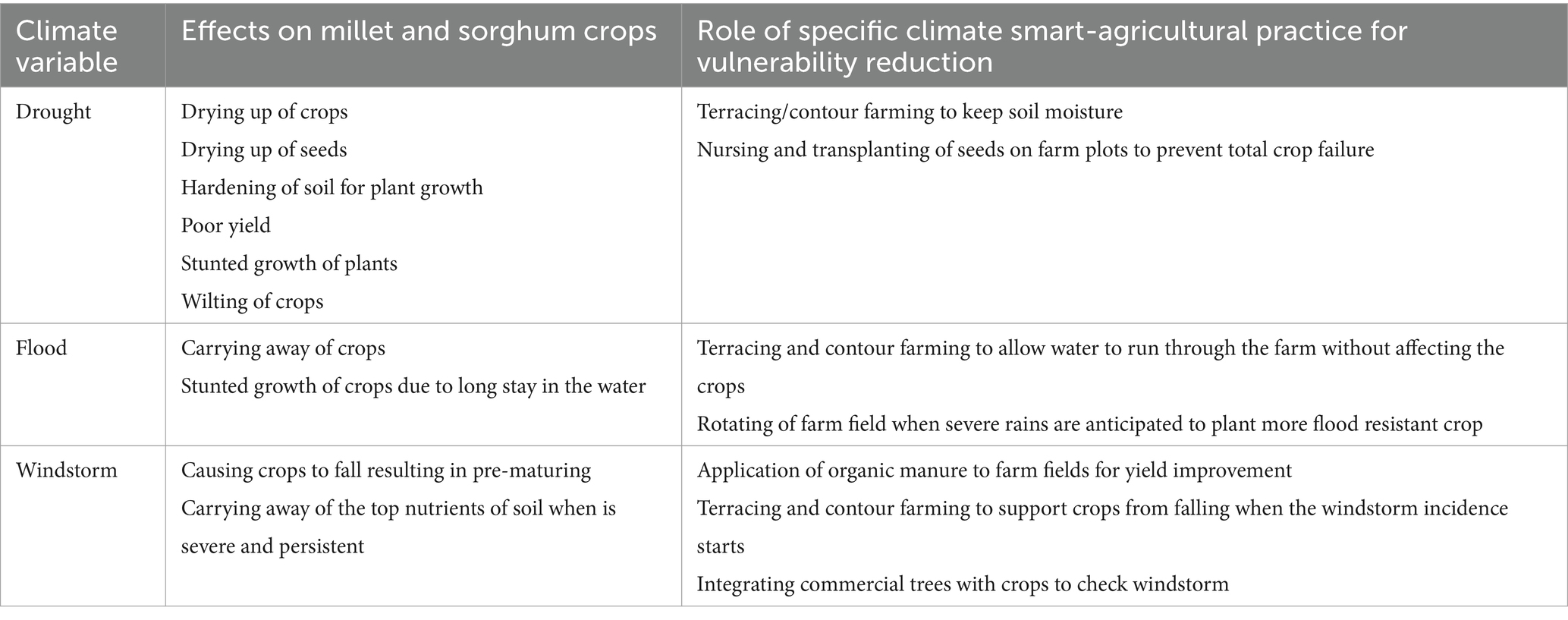
Table 6. Contributions of CSA in reducing climate change vulnerability of millet and sorghum farmers.
However, farmers’ adoption of CSA practices such as nursing and transplanting and terracing and contour farming has minimized their exposure to drought and its effects on farm yield. According to the farmers, nursing and transplanting of crops has helped them adjust their farming to meet the effects of erratic rainfall. Nursing and transplanting have helped them improve their crop yield through improvement in the density of crops on the farm plots., Nursing and transplanting of crops over the years has also aided them to get enough yield to take care of their households amidst climate change as captured by B2:
“Nursing and transplanting have been with us since time immemorial, and has been good in supporting farmers respond to drought every year. Initially, I was not practicing it because my crops never failed me. However, in recent times, due to persistent drought and its resultant effects on plant germination, the approach has been helpful to me and others. This is because, when the planted seeds failed to germinate, the nursed plants can be transplanted in those spaces of the dried-up crops. This over the years helps us get enough yields from our farm plots to support our household food needs amidst drought.”
For the farmers, nursing and transplanting provide an avenue to do sustainable farming within farm plots. The interview participants added that proper nursing and transplanting of crops can increase farm yields from five bags per acre to 10 bags as captured by A5:
“Nursing and transplanting can really improve crop yield. Last year, I did proper nursing and transplanting. There was no empty space on my farm plot. I paid attention to plant spaces too. And I must let you know that I got 15 bags of millet and sorghum together from a field I used to get less than eight.”
The farmers also indicated that terracing and contour farming help them improve soil nutrients for crop development. According to the farmers, due to drought, contour farming is done to retain the little drops of rains for crop growth and development. The adoption of contouring farming provides reservoirs to catch and retain rainwater permitting increased infiltration and more uniform distribution of the water as captured by C1:
“Contour farming as CSA practice has indeed helped us get more yield on our farm plots due to minimum water availability for crops to develop. Due to limited rainfall, the adoption of the practice has been useful. It helps us get more yield than when plants were planted on bare ground.”
3.6 Relationship between climate-smart agricultural practices of millet and sorghum and climate change vulnerability reduction
To establish the relationship between CSA and climate change adaptation, a chi-square analysis was performed. As represented by Table 7, except monocropping which has no association between CSA climate change vulnerability reductions among farm households in the Lawra Municipality, all the other CSA technologies essentially determine climate change risk reduction. For instance, land rotation/fallowing as CSA practice has a significant relationship with climate vulnerability reduction at 10% with chi-square value of 3.473. Agroforestry and manure application as CSA practices significantly relate with climate change vulnerability reduction at 5 and 1% with chi-square values of 3.014 and 4.571, respectively. Crop rotation and crop transplanting were also found to have association with climate change vulnerability reduction at 5 and 1% with chi-square values of 3.121 and 6.713, respectively. Finally, early weeding for weeds control and contour farming as CSA practices were significantly associated with climate change vulnerability reduction at 5% with chi-square values of 3.101 and 5.342, respectively. In conclusion, the chi-square revealed that as more farmers are recruited to be part of the study, the higher the possibility in adoption of any of these CSA practices.
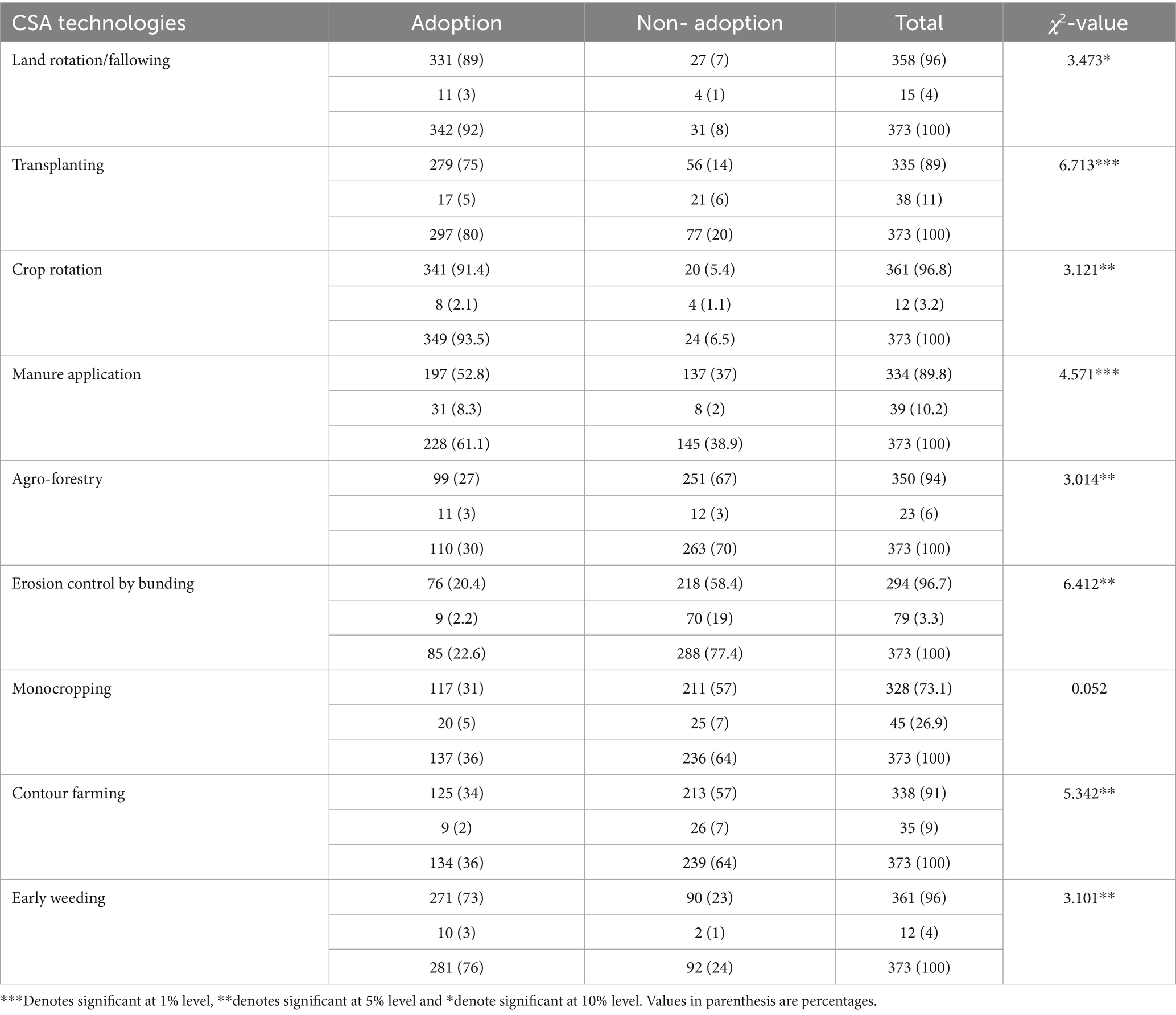
Table 7. Relationship between climate-mart agricultural practices of millet and sorghum and climate change vulnerability reduction.
3.7 Relationship between demographic characteristics of farmers and climate-mart agricultural practices adoption
The study presents the relationship between demographic characteristics of farmers and climate-mart agricultural practices adoption (see Table 8). As indicated in Table 8, age has a significant difference (at 10%) with crop rotation, agroforestry, manure application and crop transplanting but has no significant association with terracing. This implies that age influences the adoption decisions of crop rotation, manure application, crop transplanting and agroforestry. Farming purpose was found to be significantly related with crop rotation, terracing and crop transplanting at 5% with Chi Square values of 11.01, 8.91 and 7.13, respectively. The test found no significant difference between purpose of farming and manure application. Level of education of farmers has significant difference with crop transplanting at 1% with Chi Square value of 9.01 and agro-forestry at 5% with Chi Square value of 4.12. The test revealed no significant association between crop rotation and manure application. Farmers source of farming information is found to be significantly related with crop rotation at 1%, and agro forestry and terracing at 5%. Manure application and crop transplanting are associated with farmers source of farming information at 10%. Asset holding capacity has a significant difference with agro-forestry at 5% while terracing and manure application are associated with asset holding capacity at 10%. Gender and crop rotation has significant difference as well as terracing at 10%.
For climate information, the test results found an association between climate information and changing of planting dates, mixed cropping and improved crop varieties at 1 and 5%, respectively. The climate information was also found to be significantly related with inorganic fertilizer at 10%. This means that as farmers have access to climate information, the probability of farmer implementing changing of planting dates, mixed cropping and improved crop varieties. In terms of credit, inorganic fertilizer application and improved crop varieties were found to be significantly related at 1%. A significant difference was found between credit and agroforestry, improved animal husbandry and small-scale irrigation at 5%. Farm size was also found to be significantly associated with inorganic fertilizer, small-scale irrigation, mulching, terracing, and compositing at 5% whereas farm size was significantly associated with organic fertilizer at 1%.
4 Discussion
Climate-smart agriculture is widely acceptable as an approach to promote sustainable farming. Agricultural sustainability is critical to provide the food needs of the people especially those livelihoods that are strongly connected to the environment (Asrat and Simane, 2017; Anuga et al., 2019; Sullo et al., 2020). This interconnectedness between sustainable farming and agricultural sustainability places climate-smart agriculture as a core value to provide many households with their food demand. In this study, climate-smart agriculture is found to play key role in maintaining a balance between household food security and people’s existence. The study observed that climate-smart agriculture has helped farmers to reduce their vulnerability to climate extremes. As revealed by the study, climate change dictates the food consumption pattern of many households through drought, floods, windstorms, imminent bush fires and dry spells. The results indicated that drought results in drying up of crops, stunted growth of crops and poor germination of crops while floods result in carrying away of crops, decay of crops and stunted growth due to long stay in the water. Windstorms as precipitated by climate change is found by the study to cause falling down of crops and carrying away of fertile top soil suitable for crop growth and development.
Despite these climate-induced events on crop growth and development, the study found that farmers are using climate-smart agricultural approaches to respond to them. The study found that crop rotation, land rotation/fallowing, crop transplanting, manure application, agroforestry, mono cropping, and contour/terracing are existing climate-smart agricultural practices which farmers are using to improve their crop yield amidst climate change. For instance, manure application, crop rotation and land rotation as CSA practices, according to the study, have aided farmers to maintain soil quality for the cultivation of their food crops. Crop transplanting is found to improve crop yield due to coverage of the farm plots with the transplanted seeds. Earlier studies have reported on the impact of climate change on food crop production, dry spells, meteorological droughts, flooding, and unreliable rainfall, cropping calendar changes and increased atmospheric temperature (Anwaruzzaman and Hoque, 2024; Kiprono et al., 2024). Changes in precipitation patterns increase the likelihood of short-run crops failure and long-run production declines. Populations in developing world, which are already vulnerable and food insecure, are observed to be most seriously affected. In South Asia, climate change is reported to have multiple effects on irrigated yield across the region with yield reduction reported to decline annually (Pequeno et al., 2024). In sub-Saharan Africa, yields of staple crops are reported to be on the decline with implications on household food security. Studies across Kenya, Tanzania, Uganda and many other countries in Africa reported decline in the yield of both staple and cash crops (Tongruksawattana and Wainaina, 2019; Twongyirwea et al., 2019). Nana (2019) study on climate change and agriculture in Burkina Faso reported that, climate change and its extremes such as drought floods and drought spells have placed constraints on activities of agriculture with dire repercussion on household food security. The study further reported that soil, water and land which are preconditions for successful farming have been affected by climate change and its extremes.
Given the implication of climate change on farm productivity, studies have found climate-smart farming practices as a sustainable solution to sustainable farming. As typified by the study, CSA has enabled farmers to meet their food needs in the Lawra Municipality. Earlier studies across the globe have provided evidence on the role of CSA on climate-change vulnerability reduction of farmers (Chitakira and Ngcobo, 2021; Nkumulwa and Pauline, 2021). For instance, a study by Nkumulwa and Pauline (2021) on the role of CSA in enhancing farmers’ livelihoods and sustainable forest management in Kilidi District in Tanzania reported that CSA adoption by farmers has enhanced food security of many farm households. Chitakira and Ngcobo’s (2021) study on the uptake of climate smart agriculture in peri-urban areas of South Africa’s Economic Hub found that CSA practices such as mulching, cover cropping, crop rotation and the use of crop varieties have supported peri-urban farmers to meet their household needs. Using a combination of desktop studies, interviews and surveys to investigate the state of CSA in Nigeria, Cameroon and the Demographic Republic of Congo, Nwajiuba et al. (2015) found that smallholder farmers in these countries are already using climate smart approaches in their farming practices to improve their household food needs. Tesfaye W. et al. (2021) study in Ethiopia on climate-smart innovations and rural poverty reported that climate-smart technologies such as cereal-legume intercropping, minimum tillage and their combination (cereal-legume plus minimum tillage) has helped reduce the incidence and depth of poverty of smallholder farmers. CSA practices among farmers is central to promoting household needs not only in developing countries but in areas of developed destinations where agriculture still plays a significant role.
As found in the study, demographic characteristics such as household asset holding capacity, credit, extension services and climate information determine farmers’ adoption decisions of the CSA practices. For instance, household asset holdings are indicators of wealth. Farmers who are wealthy are able to take advantage of climate smart agricultural technologies that are labor or capital intensive because of affordability. Studies have reported on household assets, and found that household assets exert a positive effect on adoption of climate smart agricultural technology for climate change vulnerability reduction (Van Aelst and Holvoet, 2018; Tongruksawattana and Wainaina, 2019). Other studies have reported mixed findings on household size, education, climate information as determinants in adoption of climate-smart agricultural technologies (Ali and Erenstein, 2017; Wu et al., 2018). Thus, households that have large membership tend to have enough labor force to assist in the adoption of agricultural technologies. For instance, adoption of agroforestry, manure application, manual irrigation and terracing require more supporting hands to implement them.
5 Conclusion and policy recommendation
Climate change scenarios indicate substantial reductions in the yield of staple food crops due to drought, high temperature, and rainfall variability. This observed negative impacts would directly determine food security of majority of household in sub-Saharan Africa. This call for dramatic change in food and agricultural food systems to include building farmers’ resilience and adaptability to climate shocks. The study, using interviews and questionnaire with 146 smallholder farmers in the Lawra Municipality interrogated the contributions of CSA practices in reducing millet and sorghum farmers vulnerability to climate change. The study found a number of CSA practices such as weed control, land rotation, crop rotation etc. millet and sorghum farmers deployed to respond to drought, dry spells, and floods, which are annual climate events of the area. The study further found that adoption of CSA practices for climate change adaptation is influenced by access to credit and extension services, asset holding capacity and climate information. Given the importance of millet and sorghum to the people of the Municipality, in terms of food and other cultural functions and the criticality of weed control, land rotation and crop rotation, the study recommends the need for continuous technical support to include extension services, credit, and climate information to farmers to sustainably adopt these CSA practices for improved food production. Again, the study recommends the need for other non-governmental organizations and development partners especially Center for Indigenous Organization and Development and the German Development Cooperation Agency, which over the years have shown interest in promoting CSA practices among farmers, to support and promote the adoption of CSA by farmers. Promotion and adoption of CSA practices across the globe has the potency to improve agricultural returns, while facilitating access to sustainable food among farm households in Ghana and across the world.
5.1 Limitations of the study
The study was conducted in only Lawra Municipality, and generalizing the results to the whole region or country may not reflect specific situations. Further research in the area needs to be conducted across the region and country to provide more evidence-based findings that affect sustainable farming in the context of climate change and sustainable farming across the country.
Data availability statement
The raw data supporting the conclusions of this article will be made available by the authors, without undue reservation.
Ethics statement
There is no ethical approval from an appropriate ethics committee for this manuscript. SD Dombo University of Business and Integrated Development Studies is a new university, and institutional ethics review board is yet to be constituted. Given that there is absence of an institutional ethics review board of the University, informed consent was sought from the study participants, which the research team believed that, that was enough for a study on climate vulnerability reduction through climate-smart agriculture adoption.
Author contributions
GY: Conceptualization, Methodology, Writing – original draft, Writing – review & editing. SB: Data curation, Writing – review & editing. ED: Supervision, Validation, Writing – review & editing.
Funding
The author(s) declare that no financial support was received for the research, authorship, and/or publication of this article.
Conflict of interest
The authors declare that the research was conducted in the absence of any commercial or financial relationships that could be construed as a potential conflict of interest.
Publisher’s note
All claims expressed in this article are solely those of the authors and do not necessarily represent those of their affiliated organizations, or those of the publisher, the editors and the reviewers. Any product that may be evaluated in this article, or claim that may be made by its manufacturer, is not guaranteed or endorsed by the publisher.
References
Agyakinla, J. K. (2018). Effects of adaptation to climate changes on millet and sorghum production in the Builsa South District of Ghana, Kumasi. Ghana: Unpublished document.
Alexander, S. (2019). What climate-smart agriculture means to members of the Global Alliance for climate-smart agriculture. In: Future of Food: J. Food Agricul. Soc. 7, 21–30.
Ali, A., and Erenstein, O. (2017). Assessing farmer use of climate change adaptation practices and impacts on food security and poverty in Pakistan. Climate Risk Manage. 16, 183–194. doi: 10.1016/j.crm.2016.12.001
Ali, H., Menza, M., Hagos, F., and Haileslassie, A. (2023). Impact of climate smart agriculture on households’ resilience and vulnerability: an example from central Rift Valley, Ethiopia. Clim. Resilience Sust. 2:e254. doi: 10.1002/cli2.54
Antwi-Agyei, P., Wiafe, E. A., Amanor, K., Baffour-Ata, F., and Codjoe, S. N. A. (2021). Determinants of choice of climate change adaptation practices by smallholder pineapple farmers in the semi-deciduous forest zone of Ghana. Environ. Sust. Indic. 12:100140. doi: 10.1016/j.indic.2021.100140
Anuga, S. W., Gordon, C., Boon, E., and Surugu, J. M. I. (2019). Determinants of climate smart agriculture (CSA) adoption among smallholder food crop farmers in the techiman municipality, Ghana. Ghana. J. Geogr. 11, 124–139. doi: 10.4314/gjg.v11i1.8
Anwaruzzaman, A. K. M., and Hoque, S. (2024). “Farmers in the environment of climate change: a study of adaptation and coping strategies in West Bengal” in Climate change, vulnerabilities and adaptation: understanding and addressing threats with insights for policy and practice, eds. A. L. Singh, S. Jamal, and W. S. Ahmad 295–317.
Asrat, P., and Simane, B. (2017). Characterizing vulnerability of crop-based rural systems to climate change and variability: agro-ecology specific empirical evidence from the Dabus watershed, north-West Ethiopia. Am. J. Clim. Chang. 6, 643–667. doi: 10.4236/ajcc.2017.64033
Attride-Stirling, J. (2001). Thematic networks: an analytic tool for qualitative research. Qual. Res. 1, 385–455. doi: 10.1177/146879410100100307
Autio, A., Johansson, T., Motaroki, L., Paola Minoia, P., and Pellikka, P. (2021). Constraints for adopting climate-smart agricultural practices among smallholder farmers in Southeast Kenya. Agric. Syst. 194:103284. doi: 10.1016/j.agsy.2021.103284
Ayanlade, A., Smucker, T. A., Nyasimi, M., Sterly, H., Weldemariam, L. F., and Simpson, N. P. (2023). Complex climate change risk and emerging directions for vulnerability research in Africa. Clim. Risk Manag. 40:100497. doi: 10.1016/j.crm.2023.100497
Azadi, H., Moghaddam, M. S., Burkart, S., Mahmoudi, H., Van Passel, S., Kurban, A., et al. (2021). Rethinking resilient agriculture: from climate-smart agriculture to vulnerable-smart agriculture. J. Clean. Prod. 319:128602. doi: 10.1016/j.jclepro.2021.128602
Bazzana, D., Foltz, J., and Zhang, Y. (2022). Impact of climate smart agriculture on food security: an agent-based analysis. Food Policy 111:102304. doi: 10.1016/j.foodpol.2022.102304
Belford, C., Huang, D., Ahmed, Y. N., Ceesay, E., and Sanyang, L. (2023). An economic assessment of the impact of climate change on the Gambia’s agriculture sector: a CGE approach. Int. J. Clim. Change Strategies Manage. 15, 322–352. doi: 10.1108/IJCCSM-01-2022-0003
Chitakira, M., and Ngcobo, N. Z. (2021). Uptake of climate smart agriculture in Peri-urban areas of South Africa's economic hub requires up-scaling. Front. Sustainable Food Syst. 5:706738. doi: 10.3389/fsufs.2021.706738
Derbile, E. K., Bonye, S. Z., and Yiridomoh, G. Y. (2022). Mapping vulnerability of smallholder agriculture in Africa: vulnerability assessment of food crop farming and climate change adaptation in Ghana. Environ. Challenges 8:100537. doi: 10.1016/j.envc.2022.100537
Eggen, M., Ozdogan, M., Zaitchik, B., Ademe, D., Foltz, J., and Simane, B. (2019). Vulnerability of sorghum production to extreme, sub-seasonal weather under climate change. Environ. Res. Lett. 14:045005. doi: 10.1088/1748-9326/aafe19
Fetters, M. D., Curry, L. A., and Creswell, J. W. (2013). Achieving integration in mixed methods designs—principles and practices. Health Servic. Res 48, 2134–2156.
File, D. J., and Derbile, E. K. (2020). Sunshine, temperature and wind: community risk assessment of climate change, indigenous knowledge and climate change adaptation planning in Ghana. Int. J. Clim. Change Strategies Manage. 12, 22–38. doi: 10.1108/IJCCSM-04-2019-0023
File, D. J. M. B., Jarawura, F. X., and Derbile, E. K. (2023). Adapting to climate change: perspectives from smallholder farmers in North-Western Ghana. Cogent Soc. Sci. 9:2228064. doi: 10.1080/23311886.2023.2228064
Greenwood, P. E., and Nikulin, M. S. (1996). A guide to chi-squared testing, vol. 280. New York, NY: John Wiley & Sons.
Issahaku, G., and Abdulai, A. (2019). Adoption of climate-smart practices and its impact on farm performance and risk exposure among smallholder farmers in Ghana, Australia. J. Agric. Resour. Econ. 64, 396–420. doi: 10.1111/1467-8489.12357
Jamil, I., Jun, W., Mughal, B., Raza, M. H., Imran, M. A., and Waheed, A. (2021). Does the adaptation of climate-smart agricultural practices increase farmers’ resilience to climate change? Environ. Sci. Pollut. Res. 28, 27238–27249. doi: 10.1007/s11356-021-12425-8
Johnson, R. B., Onwuegbuzie, A. J., and Turner, L. A. (2007). Toward a definition of mixed methods research. J. Mixed Methods Res. 1, 112–133. doi: 10.1177/1558689806298224
Kiprono, M. J., Nyantika, D., and Ekisa, G. T. (2024). Effects of rainfall variability on maize production among the small-scale farmers in Endebess Sub County between 2008–2018.
Li, J., Xia, E., Wang, L., Yan, K., Zhu, L., and Huang, J. (2022). Knowledge domain and emerging trends of climate-smart agriculture: a bibliometric study. Environ. Sci. Pollut. Res. 29, 70360–70379. doi: 10.1007/s11356-022-20796-9
Makate, C., Makate, M., Mango, N., and Siziba, S. (2019). Increasing resilience of smallholder farmers to climate change through multiple adoption of proven climate-smart agriculture innovations. Lessons from southern Africa. J. Environ. Manage. 231, 858–868. doi: 10.1016/j.jenvman.2018.10.069
Martey, E., Etwire, P. M., and Abdoulaye, T. (2020). Welfare impacts of climate-smart agriculture in Ghana: does row planting and drought-tolerant maize varieties matter? Land Use Policy 95:104622. doi: 10.1016/j.landusepol.2020.104622
Mashi, S. A., Inkani, A. I., and Oghenejabor, O. D. (2022). Determinants of awareness levels of climate smart agricultural technologies and practices of urban farmers in Kuje, Abuja, Nigeria. Technol. Soc 70:102030. doi: 10.1016/j.techsoc.2022.102030
Mehraj, S., Pandit, A. H., Ali, M. T., Rather, A. M. U. D., Bisati, I. A., Malik, H. A., et al. (2023). Climate change: -general overview and implications on agriculture and allied sectors. Clim. Change Microbiome Dyn. Carbon Cycle Feedbacks 1, 97–110. doi: 10.1007/978-3-031-21079-2_7
Miller, V., Giles, J., Khan, M., Mumtaz, H., Savelli, A., and Grosjean, G. (2021). Climate-smart agriculture in Khyber Pakhtunkhwa, Pakistan. CSA country profiles for Asia series. Rome: Alliance of Bioversity International, 53.
Ministry of Food and Agriculture. (2010). [MOFA] Agriculture and Land use in the Upper West Region, Wa, Ghana. (Unpublished document).
Nana, T. J. (2019). Impact of climate change on cereal production in Burkina Faso. J. Agric. Environ. Sci. 8, 14–24. doi: 10.15640/jaes.v8n1a2
Njogu, J. W., Karuku, G., Busienei, J., and Gathiaka, J. K. (2024). Assessing determinants of scaling up pathways for adopted CSA climate smart agricultural practices: evidence from climate smart villages in Nyando Basin, Kenya. Cogent Food Agric. 10:2316362. doi: 10.1080/23311932.2024.2316362
Nkumulwa, H. O., and Pauline, N. M. (2021). Role of climate-smart agriculture in enhancing Farmers' livelihoods and sustainable Forest management: a case of villages around Songe-Bokwa Forest, Kilindi District, Tanzania. Front. Sustainable Food Syst. 5:671419. doi: 10.3389/fsufs.2021.671419
Nwajiuba, C., Emmanuel, T. N., and Bangali Solomon, F. A. R. A. (2015). “State of knowledge on CSA in Africa: case studies from Nigeria, Cameroun and the Democratic Republic of Congo” in Forum for agricultural research in Africa, Accra, Ghana, FARA Publications.
Nyang'au, J. O., Mohamed, J. H., Mango, N., Makate, C., and Wangeci, A. N. (2021). Smallholder farmers’ perception of climate change and adoption of climate smart agriculture practices in Masaba south Sub- County, Kisii, Kenya. Heliyon 7:e06789. doi: 10.1016/j.heliyon.2021.e06789
Owusu, V., Ma, W., Emuah, D., and Renwick, A. (2021). Perceptions and vulnerability of farming households to climate change in three agro-ecological zones of Ghana. J. Clean. Prod. 293:126154. doi: 10.1016/j.jclepro.2021.126154
Owusu, V., and Yiridomoh, G. Y. (2021). Assessing the determinants of women farmers' targeted adaptation measures in response to climate extremes in rural Ghana. Weather Clim. Extremes 33, 100353–100357. doi: 10.1016/j.wace.2021.100353
Pequeno, D. N., Ferreira, T. B., Fernandes, J. M., Singh, P. K., Pavan, W., Sonder, K., et al. (2024). Production vulnerability to wheat blast disease under climate change. Nat. Clim. Chang. 14, 178–183. doi: 10.1038/s41558-023-01902-2
Pereira, L. (2017). “Climate change impacts on agriculture across Africa” in Oxford research encyclopedia of environmental science (Oxford: Oxford University Press).
Petrakis, P. E., Kostis, P. C., Kafka, K. I., and Kanzola, A. M. (2023). “Alternative economic futures and sustainable development” in The future of the Greek economy: economic development through (Cham: Springer International Publishing), 135–144.
Prasad, P. V. V., and Staggenborg, S. A. (2009). “Growth and production of Sorghum and millets” in Soils, plant growth and crop production—Volume II, encyclopedia of life support systems (Oxford: Eolss Publishers).
Rainforest Alliance Anwaruzzaman, A. K. M., and Hoque, S. (2024). Summary: climate-smart agriculture in the 2017 SAN sustainable agriculture standard. Switzerland: Springer Nature.
Rurinda, J., Mapfumo, P., Van Wijk, M. T., Mtambanengwe, F. V., Rufino, M. C., Chikowo, R., et al. (2014). Sources of vulnerability to a variable and changing climate among smallholder households in Zimbabwe: a participatory analysis. Clim. Risk Manag. 3, 65–78. doi: 10.1016/j.crm.2014.05.004
Sakho-Jimbira, S., and Hathie, I. (2020). The future of agriculture in sub-Saharan Africa. Policy Brief 2:18.
Sarr, M., Ayele, M. B., Kimani, M. E., and Ruhinduka, R. (2021). Who benefits from climate-friendly agriculture? The marginal returns to a rainfed system of rice intensification in Tanzania. World Dev. 138:105160. doi: 10.1016/j.worlddev.2020.105160
Seglah, P. A., Wang, Y., Wang, H., Neglo, K. A. W., Gao, C., and Bi, Y. (2022). Energy potential and sustainability of straw resources in three regions of Ghana. Sustain. For. 14:1434. doi: 10.3390/su14031434
Shahzad, M. F., Abdulai, A., and Issahaku, G. (2021). Adaptation implications of climate-smart agriculture in rural Pakistan. Sustain. For. 13:11702. doi: 10.3390/su132111702
Sullo, C., King, R., Yiridomoh, G. Y., and Doghle, K. (2020). Indigenous knowledge indicators in determining climate variability in rural Ghana. Rural. Soc. 29, 59–74. doi: 10.1080/10371656.2020.1758434
Sultan, D. D., Castets, B. M., Famien, A. M., and Baron, C. (2020). Impact of climate change in West Africa on cereal production per capita in 2050. Sustain. For. 12:7585. doi: 10.3390/su12187585
Tanti, P. C., Jena, P. R., and Aryal, J. P. (2022). Role of institutional factors in climate-smart technology adoption in agriculture: evidence from an eastern Indian state. Environ. Challenges 7:100498. doi: 10.1016/j.envc.2022.100498
Tesfaye, W., Blalock, G., and Tirivayi, N. (2021). Climate-smart innovations and rural poverty in Ethiopia: exploring impacts and pathways. Am. J. Agric. Econ. 103, 878–899. doi: 10.1111/ajae.12161
Tesfaye, A., Nigussie, A., and Ambaw, G. (2021). Monitoring socioeconomic impacts of climate-smart agricultural practices at Doyogena and Basona Worena climate-smart landscapes, Ethiopia.
Tongruksawattana, S., and Wainaina, P. (2019). Climate shock adaptation for Kenyan maize-legume farmers: choice, complementarities and substitutions between strategies. Clim. Dev. 11, 710–722. doi: 10.1080/17565529.2018.1562862
Totin, E., Segnon, A. C., Schut, M., Affognon, H., Zougmoré, R. B., Rosenstock, T., et al. (2018). Institutional perspectives of climate-smart agriculture: a systematic literature review. Sustain. For. 10:1990. doi: 10.3390/su10061990
Twongyirwea, R., Mfitumukizab, D., Barasac, B., Naggayia, B. R., Odongoa, H., Nyakatod, V., et al. (2019). Perceived effects of drought on household food security in South-Western Uganda: coping responses and determinants. Weather Clim. Extremes 24:100201. doi: 10.1016/j.wace.2019.100201
Uddin, M. N., Bokelmann, W., and Entsminger, J. S. (2014). Factors affecting farmers’ adaptation strategies to environmental degradation and climate change effects: a farm level study in Bangladesh. Climate 2, 223–241. doi: 10.3390/cli2040223
Van Aelst, K., and Holvoet, N. (2018). Climate change adaptation in the Morogoro region of Tanzania: women’s decision-making participation in small-scale farm households. Clim. Dev. 10, 495–508. doi: 10.1080/17565529.2017.1318745
Wekesa, B. M., Ayuya, O. I., and Lagat, J. K. (2019). Effect of climate-smart agricultural practices on household food security in smallholder production systems: micro-level evidence from Kenya. Agric. Food Secur. 7:80. doi: 10.1186/s40066-018-0230-0
Wu, J., Qu, J., Li, H., Xu, L., Zhang, H., Aryal, S., et al. (2018). What affects Chinese residents’ perceptions of climate change? Sustain 10:4712. doi: 10.3390/su10124712
Yamoah, F. A., and Kaba, J. S. (2022). Integrating climate-smart Agri-innovative technology adoption and agribusiness management skills to improve the livelihoods of smallholder female cocoa farmers in Ghana. Clim. Dev. 16, 169–175. doi: 10.1080/17565529.2021.2024125
Yiridomoh, G. Y. (2021). “Illegal” gold mining operations in Ghana: implication for climate-smart agriculture in northwestern Ghana. Front. Sustainable Food Syst. 5:745317. doi: 10.3389/fsufs.2021.745317
Yiridomoh, G. Y., Bonye, S. Z., Derbile, E. K., and Owusu, V. (2021). Women farmers’ perceived indices of occurrence and severity of observed climate extremes in rural Savannah, Ghana. Environ. Dev. Sustain. 2021, 1–15. doi: 10.1007/s10668-021-
Yiridomoh, G. Y., Sullo, C., and Bonye, S. Z. (2020). Climate variability and livelihood sustainability: evidence from communities along the Black Volta River in Ghana. GeoJournal 86, 1527–1543. doi: 10.1007/s10708-020-10144-0
Zakaria, A., Alhassan, S. I., Kuwornu, J. K., Azumah, S. B., and Derkyi, M. A. (2020). Factors influencing the adoption of climate-smart agricultural technologies among rice farmers in northern Ghana. Earth Syst. Environ. 4, 257–271. doi: 10.1007/s41748-020-00146-w
Zougmoré, R., Partey, S., Ouédraogo, M., Omitoyin, B., Thomas, T., Ayantunde, A., et al. (2016). Toward climate-smart agriculture in West Africa: a review of climate change impacts, adaptation strategies and policy developments for the livestock, fishery and crop production sectors. Agric. Food Secur. 5, 1–16. doi: 10.1186/s40066-016-0075-3
Keywords: climate-smart agriculture, climate vulnerability, cereal crop, climate change, food security
Citation: Yiridomoh GY, Bonye SZ and Derbile EK (2024) Reducing vulnerability to climate change among millet and sorghum farmers in Ghana: interrogating the contribution of climate-smart agriculture in northwestern Ghana. Front. Sustain. Food Syst. 8:1357355. doi: 10.3389/fsufs.2024.1357355
Edited by:
Seth Etuah, Kwame Nkrumah University of Science and Technology, GhanaReviewed by:
Issah Baddianaah, William V. S. Tubman University, LiberiaFrank Baffour-Ata, Kwame Nkrumah University of Science and Technology, Ghana
Copyright © 2024 Yiridomoh, Bonye and Derbile. This is an open-access article distributed under the terms of the Creative Commons Attribution License (CC BY). The use, distribution or reproduction in other forums is permitted, provided the original author(s) and the copyright owner(s) are credited and that the original publication in this journal is cited, in accordance with accepted academic practice. No use, distribution or reproduction is permitted which does not comply with these terms.
*Correspondence: Gordon Yenglier Yiridomoh, eWlyaWRvbW9oQGdtYWlsLmNvbQ==
 Gordon Yenglier Yiridomoh
Gordon Yenglier Yiridomoh Samuel Ziem Bonye1
Samuel Ziem Bonye1